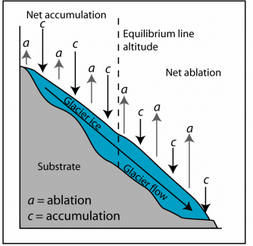Mass balance is a critical yet straightforward process through which the ocean may control ice in ocean water to prevent rising sea levels. In other words, it is the quantitative expression of changes in the volume of the glacier over a specific period. The process’s primary goal is to create an equilibrium between ocean water and the amount of frost that is submerged (Shepherd et al., 2020). The entire process requires such inputs as rain, snow, and hail to help promote the accumulation and output, such as erosion, percolation, and melting of the ice to assist in the reduction of the ice.
The glacier mass is linked to the mass balance through a constant struggle to maintain the equilibrium state. In most cases, both the input and output processes must continue to promote the accumulation and the removal of excessive matters through the ablation process. In most cases, the collection of the glacier material is regarded as positive, while a high reduction level is referred to as a negative change (Shepherd et al., 2020). Therefore, the entire process is critical for the promotion of ocean water stability.

Based on the above diagram, it is evident that glacial materials must move in a different direction to promote the required mass balance in ice. On the one end, these materials must strive to accumulate through the various input processes, such as precipitation, snow, and organic materials (Shepherd et al., 2020). On the other hand, the oblation process must dissolve and move the materials, hence the experienced movement in different directions.
In conclusion, mass balance is a necessary development that occurs in oceans to promote stability. In most cases, the process is facilitated by the constant movement of the water body’s inputs and outputs. These developments are critical in the realization of glaciers’ constant flow in the sea. Therefore, people should understand the principle operation of mass balance to prevent the excessive rising of the sea levels.
Reference
Shepherd, A., Ivins, E., Rignot, E., Smith, B., van Den Broeke, M., Velicogna, I., Whitehouse, P., Briggs, K., Joughin, I., Krinner, G., Nowicki, S., Payne, T., Scambos, T., Schlegel, N., Agosta, C., Ahlstrøm, A., Babonis, G., Barletta, V., Bjørk, A., … Wuite, J. (2020). Mass balance of the Greenland Ice Sheet from 1992 to 2018. Nature, 579(7798), 233-239. Web.